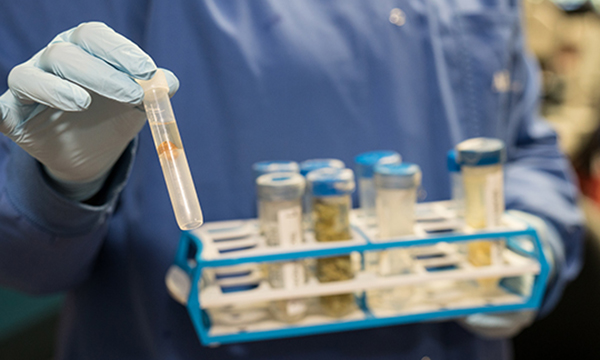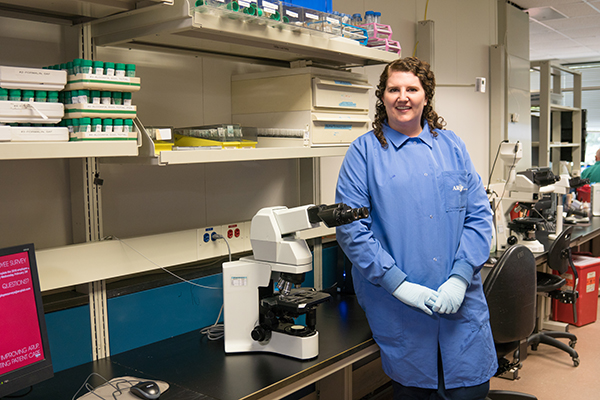
Senior medical technologist Madison Sant demonstrates organisms she and others identified in lab specimens.
Parasites are not just picked up in hot, distant countries. The technologists at ARUP Laboratories’ Parasitology and Fecal Testing (PAFT) Lab see creepers in samples all the time—because they are everywhere.
At least 14 percent of the U.S. population has been exposed to Toxocara, the parasitic roundworms found in dogs’ and cats’ intestines, according to the Centers for Disease Control (CDC). Resulting toxocariasis causes blindness in an estimated 70 people each year. Trichomoniasis, a sexually transmitted disease (STD) instigated by the parasite Trichomonas, can trigger pregnancy problems and increase the risk of contracting other STDs. It affects 3.7 million people in the United States, but is treatable.
Fortunately, handwashing and other precautions can prevent most parasitic infections, and many diagnosed illnesses are treatable. To that end, the PAFT Lab tests blood, stool, and other samples to identify invaders. Worldwide, parasites are a menace: In 2013 alone, more than 1 million people died internationally from parasites, according to the Global Burden of Disease Study 2013.
Madison Sant“You’re analyzing the patient’s specimen, figuring out the mystery of what’s wrong. You’re helping the patient so much, but you’re not necessarily the doctor or the nurse in the room with them.”
Senior Medical Technologist, PAFT Lab.
Madison Sant in the PAFT Lab tells us what it is like to test for unknown creatures in bodily fluids each day.
Aside from noticing and diagnosing parasites, what is important in PAFT work?
We can be a useful source of education on parasites because we see them every day. The other day, for instance, we saw a Strongoloides. That’s a type of roundworm, versions of which can infect birds, reptiles, amphibians, livestock, and primates. Humans who encounter free-living larvae in soil can sometimes be infected through their skin, although they may not experience symptoms. The medical doctor who sent the specimen requested images of the organism to show to his clinical staff. He was excited to get the teaching images.
We also set aside unique and interesting organisms to show to the [University of Utah] medical microbiology fellows, who conduct observational rounds at ARUP. If we see an interesting tick, Giardia (the cause of an intestinal infection marked by abdominal cramps and other symptoms), hookworm eggs, or something else, we show it to them unlabeled, then let them see if they can identify it. Each time they visit, we have something new for them to see.

What happens in this lab?
We receive specimens of blood, stool, skin scrapings, eye swabs, body fluids, and other sources. Hundreds of specimens are tested in batches each day. That said, depending on your bench in the lab, your work may be less fast paced and more about troubleshooting. Some exceptions would be malarial smears, or Acanthamoeba cultures (to test for a parasite that affects eyes), which are critical and must be performed quickly. But for some benches, you can spend your whole day doing ova and parasite examinations, for instance, investigating for one of at least 50 organisms that could appear there. You’ll be reading stained slides using a microscope, looking for eggs, cysts, or other signs of parasites. That can be really interesting.
What training does a technologist in PAFT have?
Each of us learned parasitology in our medical laboratory science (MLS) or biology training. However, we go further in the lab. Trainers show PowerPoint slides of the life cycles of the organisms involved, so technologists know how they appear at different stages. We take a series of competency tests. Once we pass the competencies, we can read ova and parasite exams and other exams on our own.
It’s a very collaborative lab. If we need backup and are seeing an organism that we haven’t seen often, or maybe we have a low-resolution slide to examine, we can ask other technologists to help identify the organism. It’s nice, having a great team there to help.
How did you get into parasitology?
My bachelor of science is in MLS, although I started college in physiology and developmental biology. My brother, a former ARUP employee, advised me to switch to MLS. He helped me understand that I could examine specimens, and that I could work in a lab without being a research scientist.
Before my current job, I worked as a technologist in Bacteriology and Infectious Diseases Rapid Testing. But I’ve always loved parasitology, so I applied here when a friend mentioned an opening to me.
What do you enjoy about your work?
Parasitology is different every single day, and I’m never bored. I’ll see a new organism that I don’t remember from school, then check my textbook and recall the life cycle and how different it can look at various stages.
My work is so much more than just loading instruments and doing quick reads of a specimen. In PAFT, we have to know what we’re seeing and examine it carefully for a special kind of accuracy. I also like that I have very specialized knowledge, much more than I gained from school. And it’s great that we can move from bench to bench, not be stuck in one position in the lab.
This is an intriguing medical field. You’re analyzing the patient’s specimen, figuring out the mystery of what’s wrong. You’re helping the patient so much, but you’re not necessarily the doctor or the nurse in the room with them.
Catherine Arnold, Science Communications Writer
Related blogs
"New Technology Diagnoses Pneumonia Caused by Previously Undetected Pathogens"
University of Utah Health The Scope Radio interviews with Kristin Case, technical supervisor, PAFT Lab
















